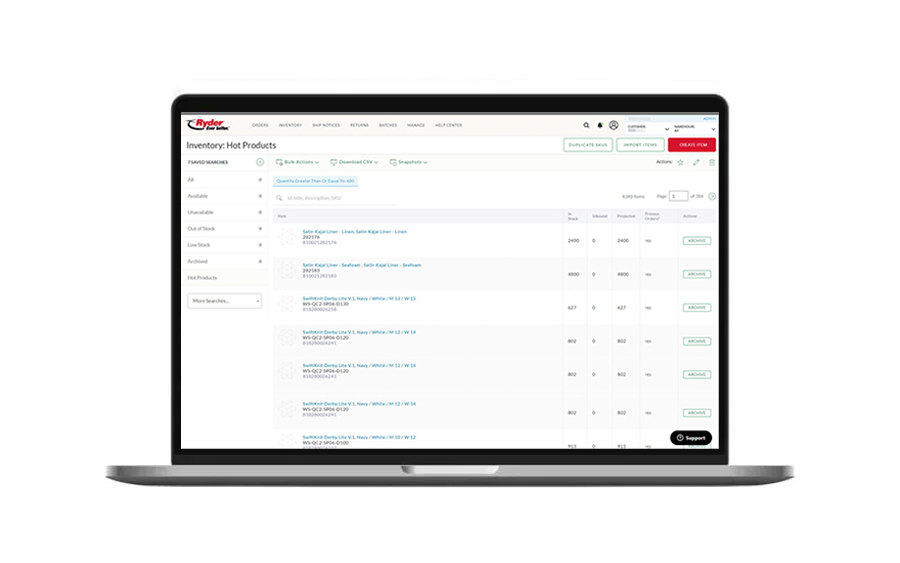Logistics
Industries
Technology & Innovations
E-commerce
E-commerce Fulfillment Services
Lease & Maintenance
Semi Trucks
Logistics
E-commerce
Lease & Maintenance
Buy Used Trucks

[Updated post from November 18th, 2021]
Imagine that you're browsing an e-commerce website and find a product that you're interested in. You decide to visit the brand's nearest store location so you can view it in person and ask a store associate some questions.
But here's the catch: The product page doesn't provide you with any inventory information
If a customer has reached the point of checking inventory levels, this indicates a high intent to purchase. Despite this, just 38% of retailers show basic inventory availability on their websites. By not supplying this information, you're missing out on some easy sales.
This is just one example of how full inventory visibility is essential to offering a convenient, hassle-free shopping journey that boosts customer satisfaction.
We're going to cover why inventory visibility matters, how to improve inventory visibility, and how partnering with Ryder opens the door to real-time inventory insights that streamline your fulfillment operation.
Inventory visibility refers to a business's ability to track and manage inventory in real time across multiple locations and selling channels. This includes knowing how much inventory is on hand at any given time, where different SKUs are stored, the status of outstanding orders, and having access to accurate forecasting on future demand for different products.
In today's dynamic retail environment, real-time inventory visibility is essential to meet consumer demand for seamless, always-on shopping experiences. Customers expect to have multiple product options available to them across several sales channels, enabling them to shop online and offline as they see fit. By improving inventory tracking and visibility, businesses can better meet customer expectations, improve supply chain transparency, and make smarter decisions about inventory management, such as:
If your business is relying on manual inventory tracking and/or cannot answer basic questions about where your inventory is or how much you have, lost sales opportunities will add up quickly – not to mention eroded profits due to higher storage and supply chain costs.
More accurate forecasting and inventory data hold the key to optimizing your fulfillment process and identifying where time/resources are being wasted. For example, if inventory tracking shows that a certain SKU has a slow turnover, you may want to reset the reorder point or reconsider whether it's worth stocking that product to reduce carrying costs.
Moreover, full inventory visibility is the foundation of omnichannel retailing, which is now expected by the majority of consumers:
lf a brand doesn't have oversight of the entire supply chain, it's impossible to coordinate any of the above cross-channel activities effectively, which doesn't spell good news for CX management.
Let's look at some other ways that inventory visibility can assist your e-commerce business:
There's nothing worse than a customer placing an order online, – only to have to tell them at a later date that the SKU is no longer available for purchase. This happens when an e-commerce platform isn't synced properly with your Warehouse Management System (WMS) or no WMS is being used, resulting in inventory levels that are not aligned with what's really in your fulfillment center.
While it might be possible to save a sale by offering an alternative product, a brand may have no choice but to refund part or all of that order. In addition to lost revenue, stockouts result in poor customer experiences that damage a brand's reputation. Despite this, Shopify data reports that shoppers will experience stockouts as frequently as every third shopping trip!
By investing in real-time inventory visibility, you can make sure that the right data is being fed into your e-commerce platform and be confident in how much inventory you have on hand.
If a business doesn't have the right mix of merchandise across warehouse locations to fulfill an order, they may have no choice but to use split shipments, where a single order is split into separate packages that are shipped to the customer from different facilities.
Although they give businesses more flexibility to navigate supply chain constraints, split shipments involve higher fulfillment and shipping costs, resulting in lower profit margins – or even losses – on a sale.
Accurate inventory visibility means that your business can monitor stock levels across multiple locations and allocate orders to the facility with the necessary merchandise, helping to cut down the number of split shipments.
It's not always possible to predict excess inventory ahead of time. But a lack of visibility over your stock is one of the biggest precursors to stock piling up in your warehouses or storefront.
Why? Because if you don't have access to real-time data on how many units you're carrying of a particular SKU, it's easy to end up ordering more than you need to provide a buffer against stockouts.
But if this extra stock outstrips customer demand, you're going to find yourself with more inventory than you can sell. When a product's lifecycle is over, excess inventory turns into dead stock that costs you more money in warehousing fees than you can make in sales.
Put simply, better visibility means better warehouse management. Inventory visibility ensures you have a clear and accurate understanding of how much inventory is required. By having greater certainty over your current stock levels, you can avoid a ‘just in case' approach to inventory management that makes excess stock more likely to occur.
For more ways to manage excess inventory effectively, check out our full-length ebook with advice from our partner network.
By blending online and offline shopping capabilities, O2O (Online-to-Offline) retail maximizes convenience and flexibility by giving consumers the best of both worlds: the convenience of e-commerce and the tangibility of brick and mortar.
For example, it's often less painless for consumers to browse an online product catalog than visit to a store and comb through every single aisle. Despite this, many consumers still prefer to make purchases in-store. According to Chain Store Age, 54% of consumers prefer brick and mortar retail over shopping via mobile (21%) or desktop (18%).
Omnichannel services such as BOPIS (Buy Online, Pick-Up In-Store) and curbside pick-up have gained immense popularity as consumers embrace using multiple channels to shop. In-store returns are also booming as consumers strive to avoid return shipping costs and lengthy waits for refunds.
But if a customer wants to pick up their order in-store, you need to know whether that store has the necessary stock – and if not, whether it can be sent from another store within the timeframe required. Without real-time inventory visibility, it's impossible to coordinate O2O retail services effectively.
Due to rising customer expectations for fast and free shipping, shipping has become one of the biggest costs that e-commerce merchants have to shoulder. Although it might seem unrelated, inventory visibility plays a huge role in reducing your shipping costs and being able to meet customer demand.
If all online orders are dispatched from one central warehouse, your shipping costs are going to vary significantly between orders. While some customers will be located close to your facility, other orders will have to cross multiple shipping zones, resulting in shipping rates that are difficult for brands to predict.
While e-commerce brands manage these shifts using flat-rate shipping, standardized rates can cause you to pay over the odds for short-haul deliveries. Inventory visibility software gives brands the option of using storefronts as micro-fulfillment centers that can fulfill local orders within a certain radius. These kinds of multi-node fulfillment strategies don't just mean cheaper shipping. but getting orders to your customers much faster.
Even in 2023, there's no shortage of brands or third-party logistics (3PL) providers who are relying on manual inventory tracking and counting for inventory control. Because of the time and effort it takes to track inventory manually, stocktakes of a warehouse might only happen every few months. But when shrinkage, theft, and incorrect entry of new inventory are happening on a regular basis, it doesn't take long for stock levels to become out of whack with what's really in your warehouse. This creates poor data accuracy that opens the door to scenarios like stockouts, excess inventory, and bad quality control.
If you're relying on multiple business systems to manage inventory and warehouse organization, this can create gaps in your internal records if platforms can't share data effectively. This is a particular problem for legacy software platforms and ERP (enterprise resource planning) systems, which can be difficult to integrate with a modern inventory management system. If you're having to manually transfer data between systems, it's very challenging to increase inventory visibility without incurring a big loss in productivity.
Even an advanced inventory data platform will struggle to offer supply chain visibility if it cannot automate processes like inventory counts, backordering, and setting reorder points. Updating all of these processes manually incurs a high labor cost, and also runs the risk of human error.
When you're an emerging business, inventory management doesn't present too much difficulty. But when you start adding more warehouses or store locations into the mix, inventory accuracy and visibility can easily be lost.
Without the right inventory management software, it's almost impossible to track inventory effectively and forecast growth. This causes stockouts, order errors, and surplus inventory to mount up quickly, which lowers customer satisfaction.Partnering with a 3PL like Ryder that embraces advanced inventory management and automation makes all the difference to your ability to optimize your inventory levels and gain more control over your supply chain. Our proprietary technology platform makes it a breeze to keep track of your inventory – all from one simple, intuitive dashboard.

Search your inventory with multiple filters. Select from a wide variety of filters to search through your orders, shipments, and outstanding inventory with ease. Save your favorite searches to your dashboard for better accessibility for up-to-the-minute insights.
Seamless integrations with your e-commerce platform. The Ryder platform provides advanced two-way integrations with major e-commerce platforms including Shopify, ensuring that your inventory levels are updated every time a sale or a return is made through your store.
Set up multiple warehouse locations and Routing Rules. Set up multiple fulfillment locations through your account to pioneer a multi-node fulfillment strategy. Our Geolocation tool will automatically allocate new orders to the facility closest to your new customer. Alternatively, you can set up custom Routing Rules to route orders meeting certain parameters to specific facilities for the ultimate control over fulfillment.
Set notifications for low inventory levels. Configure custom thresholds for each of your SKUs for when inventory levels are close to your reorder point, ensuring you never find yourself without enough units to fulfill outstanding orders.
And don't just take our word for it; let's hear it straight from one of our customers:
“Before partnering with Ryder there were some services we weren't able to offer, such as in-store returns. This added a lot of friction to the customer experience. Integrated inventory management has been a real game-changer for the Calzedonia brand – and our ability to meet consumer expectations.” Marcello Veronesi, CEO of Calzedonia USA.
“The Ryder platform offered us this unique interface where we could see what was happening in the warehouse in real-time. It made us really comfortable to make the switch because we knew that we didn’t need to be close by to monitor what was happening.” Eric Girouard, Founder and CEO of Brunt Workwear.
“The Ryder platform has been the ultimate trump card for Moda Operandi. The ability to integrate so seamlessly with our online store has given us a level of flexibility and control that we’ve never had before. By setting custom Order Rules for packing and routing, we can make sure that our most valued customers receive the service they expect – every time.” Nikhil Soares, e-commerce Supply Chain and Operations Executive for Moda Operandi.